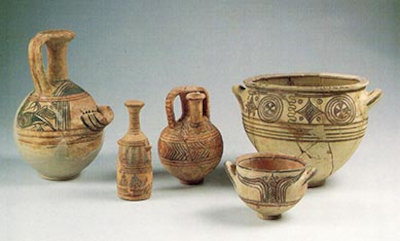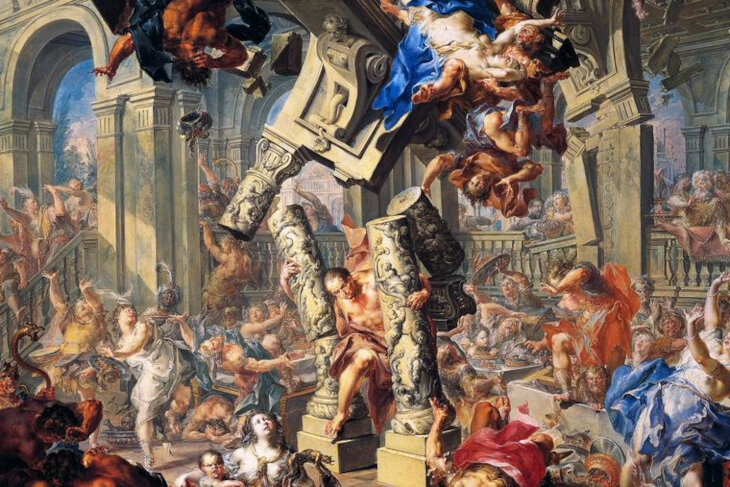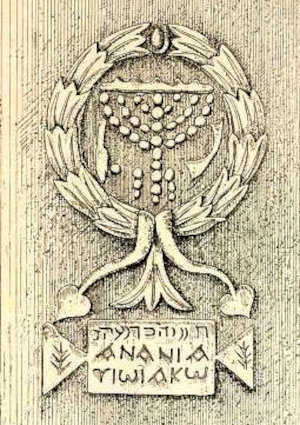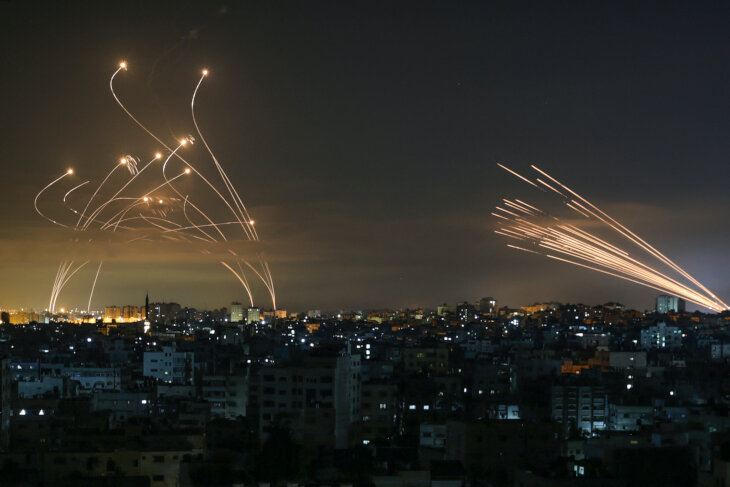 Vampire Weekend's Surprising Jewish Stories
Vampire Weekend's Surprising Jewish Stories


10 min read
10 facts about Jewish communities in Gaza, from ancient to modern times.
A Jewish rabbi in Gaza? The great Gaza Yeshiva? Ancient Jewish Gazan villages? Yes, they were all real. Here are 10 surprising facts about Jews’ long relationship with the region.
The area of Gaza has been inhabited since Neolithic times. Four thousand years ago, during the time of the Jewish patriarch Jacob, it was inhabited by a tribe known as “the Avvim who dwell in (unwalled) cities until Gaza” (Deuteronomy 2:23). When Jacob divided up the Land of Israel between his twelve sons, Gaza was allocated to Judah and his descendants.
The tribe of Judah didn’t live in Gaza; it eventually passed into Canaanite hands, then was colonized by Egypt as an outpost of the Egyptian empire.
In the 13th Century BCE, a group of Greek sailors attacked and sacked Anatolia, Cyprus, and Syria, before attacking Egypt. The earliest mention of this group is recorded inside the mortuary temple of Ramses III in Egypt; King Ramses repulsed the would-be invaders, and encouraged them to settle nearby in Gaza instead. There, the invaders called themselves Philistines (Plishtim in Hebrew).
 Philistine bichrome pottery was produced during the Iron I
Philistine bichrome pottery was produced during the Iron I
period in ancient Canaan (circa 1200–1000 B.C.E.)
The Philistines differed greatly from the Israelites who inhabited the area. Though they adopted some local customs, the Philistines continued to worship Greek gods. They also ate a diet heavy in pigs and dogs, as evidenced in archeological remains of their cities, in stark contrast to Jewish settlements of the same era.
Philistines built five cities which formed a Philistine political union: Ashkelon, Ashdod, Gath and Ekron, all in modern-day Israel, plus Gaza. The ancient Greeks called the area Philistia, which later evolved into the Greek name Palestine. Gaza became an outpost of Greek culture within ancient Judah.
Philistines were relentless enemies of the Jews; the Torah describes a terrible period in Jewish history when the “Children of Israel (were) delivered…into the hands of the Philistines” who oppressed them (Judges 13:1).
One of the most heartbreaking stories in Jewish history occurred in Gaza: Samson, a hero of Israel, went to Gaza and fell in love with a Philistine woman named Delilah. Philistine leaders urged her to pretend to be in love with Samson and to find out what made him so strong: “The governors of the Philistines went up to her and said to her, ‘Entice him and find out by what (means) his strength is so great, and by what means we may overpower him, so that we may bind him, to afflict him. Each one of us will give you eleven hundred pieces of silver” (Judges 16:1).
 Johann Georg Platzer (1704-1761), “The Death of Samson”
Johann Georg Platzer (1704-1761), “The Death of Samson”
Delilah eventually learned Samson’s secret: he possessed superhuman strength because he abstained from wine and had never cut his hair. While he was sleeping, Philistines cut off Samson’s hair then tortured him. They brought him to one of their temples to continue his torture during a great feast there. In desperation, Samson asked God for one more moment of strength, and pushed down the pillars supporting the temple, killing himself along with all the revelers inside.
As a Greek outpost, Gaza was a center of Hellenizing influence in ancient Israel and became a battle zone during the revolt of the Maccabees. Jonathan the Hasmonean – Judah Maccabee’s brother – conquered Gaza and moved there in the year 145 BCE, 20 years after the Temple in Jerusalem was captured and the miracle of one container of oil lasting for eight days. Gaza was absorbed into the Kingdom of Judah, ruled by the Jewish Hasmonean kings.
Gaza became a major Jewish center during Talmudic times, boasting magnificent synagogues and a renowned Gaza Yeshiva (Jewish school). The city of Gaza was home to a large Jewish community; the Talmud also mentions a small Jewish town in the Gaza region called Kfar Darom. In 1965, Egyptian archeologists discovered the remains of an ancient synagogue near Gaza’s harbor. Beautiful mosaic floors declared that the synagogue was built in 508-9 CE, and depicted a picture of King David, with his name written in Hebrew above.
 Menorah engraving at the Great Mosque of Gaza
Menorah engraving at the Great Mosque of Gaza
More evidence of Gaza’s ancient Jewish roots can be found in the Great Mosque of Gaza: a pillar of this mosque contains carvings of Jewish symbols: a lulav and etrog, a shofar, a menorah, plus Hebrew inscriptions. Jewish life flourished in Gaza for hundreds of years, until Crusaders destroyed the area, putting a temporary stop to normal life in the area.
Jews returned to Gaza after the devastation of the Crusades, and once again built a flourishing Jewish community. The famous author and spiritual leader Rabbi Avraham Azoulai moved to Gaza from Morocco in the early 1600s and wrote his mystical work Chesed l”Avraham there.
Around the same time, Rabbi Yisrael Najara moved from Safed to Gaza. The popular Shabbat song he wrote, Kah Ribon Olam, is a fervent plea for God to rescue Jews from danger and exile; it beseeches the Divine to “save (Israel) Your sheep from the mouth of lions….” Its words are as true in Gaza today as they were 400 years ago when they were written.
After a decade of increasing anti-Jewish rhetoric from Arab leaders in Mandatory Palestine, armed Arab groups rose up to attack Jews in August, 1929. Anti-Jewish riots began in late August in the new Jewish neighborhoods that were springing up around Jerusalem. The riots began to spread to other areas, including the cities of Safed and Hebron, and Gaza; scores of Jews were killed.
 Gaza ruins 1898 (American Colony Photograph at the Library of Congress)
Gaza ruins 1898 (American Colony Photograph at the Library of Congress)
After taking no action for six days during the riots, on August 26, 1929, British soldiers stepped in to stop the riots - and to remove Jews from areas where they’d lived for centuries. All of the Jews living in Hebron and Gaza were forced from their homes and forbidden by the British authorities to return.
Jews soon returned to Gaza and established a kibbutz, or collective farm, there in 1946. They called it Kfar Darom, after an ancient Gazan Jewish town by that name. But Jewish life in Gaza was to be short-lived. In the United Nations’ proposed division of Mandatory Palestine, Gaza itself was divided between a proposed Arab state and Israel. Israel accepted the UN’s plan, but the Arab states did not, attacking Israel the moment it declared independence in 1948. In the bitter fighting that followed, Israel captured Gaza. In subsequent ceasefire negotiations, Israel gave Gaza to Egypt in return for control over the nearby cities of Ashdod and Ashkelon. At the same time, the Arab population of Gaza swelled as Palestinians moved to Gaza from the newly founded State of Israel.
Israel conquered Gaza once more during its 1956 war with Egypt, and once again gave the territory to Egypt. During the 1967 Six Day War, Israel once again conquered Gaza. In the 1970s, Jews began to return to Gaza once again: over the next thirty years, Jews built 21 new farms and towns in Gaza. Gaza became home to most of Israel’s organic farms and accounted for 15% of Israel’s overall agricultural output.
For over a decade, Arabs and Jews lived and farmed side by side in Gaza. With the outbreak of the first Intifada in 1987, however, peaceful coexistence came to a halt. In the Oslo Accords of 1993 Israel promised to evacuate most of Gaza, giving way for it to be governed by the newly-formed Palestinian Authority. That peace agreement fell apart, however, and tensions continued to rise.
 Jewish children at a greenhouse in the Gadid settlement a week before disengagement (Photo Tom Gross)
Jewish children at a greenhouse in the Gadid settlement a week before disengagement (Photo Tom Gross)
In 2005, after heavy political pressure from world leaders and domestically, Israel agreed to withdraw from all of Gaza and to force every Jew living there out of the territory. Gaza was to be entirely self-governed; Israel believed that by disengaging, they would be free of the terrorism and international opprobrium that governing Gaza had exposed them to.
Starting on August 17, 2005, Israel’s army moved in to remove all of Gaza’s Jews. The process was highly emotional and took a week. A total of 1,700 Jewish families left their farms and homes in Gaza. Knowing that Jewish graves would be desecrated, Israel’s chief rabbis ordered all Jewish cemeteries to be dug up and their bodies reburied in Israel. .
Before Gaza became entirely “Jew free,” American Jewish donors spent $14 million buying greenhouses from the Jewish farmers there and donated them to Gaza’s new Arab government. Former World Bank President James Wolfensohn even gave half a million of his own money to the scheme. Within moments of the final Jew leaving Gaza, however, the greenhouses were utterly destroyed, looted and smashed while Gaza’s police officers stood watching.
Since 2005, anti-Jewish sentiment has swelled in Gaza. With the election of Hamas to govern the region in 2007, attacks on Israeli targets from Gaza increased. In the past 18 years, dozens of Israelis - as well as many Palestinians in Gaza and in areas under Palestinian Authority control - have been killed and injured by tens of thousands of rockets launched from Gaza. (Click here for a list of casualties preceding the October 7, 2023 attacks.) On October 7, 2023, Hamas terrorists entering Israel from Gaza perpetrated their worst massacre since the Holocaust, killing over 1,400 people and abducting over 220 prisoners.
 The Israeli Iron Dome missile defense system (left) intercepts rockets fired by Hamas in the northern Gaza Strip toward southern Israel
The Israeli Iron Dome missile defense system (left) intercepts rockets fired by Hamas in the northern Gaza Strip toward southern Israel
Long a Jewish outpost, Gaza has also been the site of some of the most intense hatred against Jews throughout history. From the ancient Philistines, to antisemitic Greeks during the Hanukkah era, to fanatical Islamist resentment today, Gaza has been a place where Jews have been targeted - and yet have managed to survive and even triumph. May it be so again soon.
View this post on Instagram
No, there are no Jewish settlements in Gaza. Jews have a long history of living in Gaza, until 2005.
No, Gaza is not part of Israel. Since 2005, Israel has not had any presence in Gaza and the Strip has been governed by the terrorist organization Hamas since 2006. In 2005, Israel withdrew from Gaza, with the Jews who were living there forced out of the territory. Since the Israeli disengagement, Hamas were elected to govern Gaza in 2007, and since then attacks on Israeli targets from Gaza have been ongoing.

Thanks so much, Dr. Miller, for documenting the ancient and continuous Jewish presence in Gaza. Great detail and evidence.
Excellent article, thank you. However, you refer to the current residents of Gaza as "Palestinians". Shouldn't a more accurate description be "Palestinian Arabs"? After all, there is no such people as simply "Palestinian". While "Palestine" was under control of the British, both Jews and Arabs were referred to as Palestinians. We know a Jewish friend of the family who was born in British-Mandate Palestine and he had a Palestinian passport. Before it was know as the "Jerusalem Post", it was called the "Palestine Post". So, we see that the term "Palestinian" simply denotes the location of where a person lives, rather than a "people". So, I would suggest it is much more accurate to refer to them as "Palestinian Arabs", or "Palestinian Muslims", etc. Thank you
Can't a Jew more intelligent than I write about Jewish Gaza as a short meme, rap song, or simple paragraph that will put an end to accusations of colonization?
Centuries old Jewish community..driven away by goym and stolen by the Arabs...Jews Reoccupy gaza make it Jewish again
Amazing! Yes, just as Israel in general, Gaza has a rich Jewish History. They are certainly moving pieces in Heaven, as we know that the events occurring in a place have much mystical connection to the past. Let us pray that that we see a revelation as to why this had to take place, and with the coming of Mashiach soon.
You may have heard that those who had mezuzos on their doorposts were not touched, and that the music festival had a statue of Buddha there. It was bad enough they were violating a religious holiday and driving cars then - which is forbidden according to Torah law, but to have a statue, what for?! Of course most there didn't know, still we see that perhaps even they had stepped over the line.
We are not here to judge others, but we should take out lessons - even a bit.
You realize that according to Jewish tradition / mesorah, those who are killed precisely because they are Jewish are considered kedoshim, holy martyrs who have sanctified God's Name in their death. As such, their remains (since we cannot say 'bodies' due to Hamas' brutality) do not need the regular cleansing process by the Chevrah Kadishah (Burial Society) since even their physical beings have achieved the necessary tikkun. Regardless of their actions in This World, they now inhabit an unimaginably sublime place in the Next World.
We, however, who are left to continue our existence in this world, are not guaranteed anything, as yet. We still have to contend with all the lures and temptations (including unwarranted and unexamined feelings of superiority) based on erroneous understanding of Hashem's great love for ALL Jews. And who is to say that deep in their hearts, and in their last moments, all these kedoshim did not evince a true recognition of their Creator and his plan in this world?
Do you really think Hashem is happy with anyone - ANYONE including or especially, someone who purports to follow his ways - denigrating one of his precious children? Olam hofuch - when we reach the Next World, we might see a world 'upside down', one in which our small minds' evaluations will be shown to be so far from truth.
Certainly the were kedoshim, but is it lashon hara (gossip - forbidden by Torah - and rabbis say even on the dead) to point out the hashgacha pratis/Divine Providece? A rabbi would have to be consulted.
Anyways, it's certainly not lashon hara to point out the glaring and obvious purposeful efforts of the Israeli government and army (most likely in cahoots with US) to allow this matter to take place. Why they did so is a good question.
You are absolutely right, One Jew's Thoughts, as the teshuvah of so many Jews in the wake of the atrocity has proven. A great many also realized this and have since taken on Shabbat, modest behavior, and much more. A great many Jews, including one of our family members, was saved when he left the party before Shabbos in order not to desecrate Shabbos.
This was such an informative article and gave a history unlike others that I have read. Much more detail and it’s very clear Gush Katif as we have known it up until 2005 is Israel’s land.
Every Palestinian should read this.Thanks to Hamas they live in misery